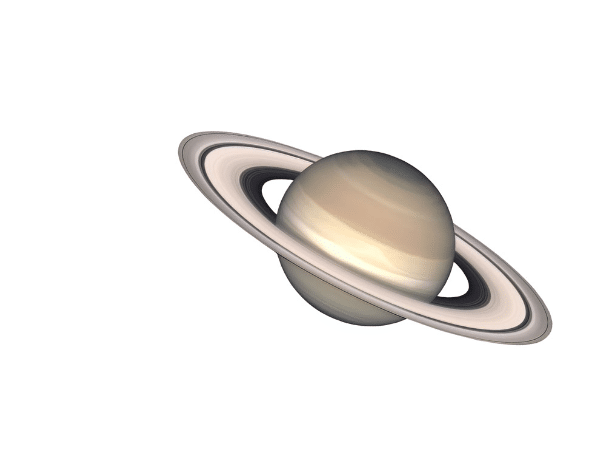Saturn is a gas giant, composed of 96% hydrogen and 3% helium, and it does not have a solid surface. Its density is so low that it could float if placed in water (CNES). It is surrounded by its famous rings, made up of countless pieces of ice and dust. The entire ring system forms a disk 72,000 km wide and less than 2 km thick. Its name, Saturnus, comes from the Roman god of agriculture.

| Caractéristiques | Saturne | Terre |
| Diamètre | 120 000 km | 12 750 km |
| Rapport de masse | 95,2 | 1 |
| Rapport de gravité | 1,02 | 1 |
| Distance de soleil (UA) | 9,54 | 1 |
| Inclinaison / Axe de rotation | 26,7° | 23,5° |
| Période de rotation | 10,66 h | 1 j |
| Révolution autour du soleil | 29,5 ans | 365 j |
| Température max | -122°C | +58°C |
| Température min | -178°C | -89°C |
| Lunes | 62 | 1 |
Saturn, the second largest planet in the Solar System, followed a process similar to that of other gas giants.
Here’s an overview of the formation of Saturn:
- Formation of the Protoplanetary Disk: Like all other planets, Saturn formed from a disk of gas and dust surrounding the young Sun, known as the solar nebula. This disk is also referred to as the protoplanetary disk.
- Accretion of Material: Within the protoplanetary disk, small dust particles began to attract each other due to gravity. These dust aggregates gradually consolidated into larger objects called planetesimals. The planetesimals then merged to form planetary embryos, which eventually became planets.
- Planetary Migration: During their formation, the planetary embryos underwent gravitational interactions with the protoplanetary disk. These interactions may have caused migratory movements, altering the orbits of the planetary embryos and affecting their final formation.
- Formation of the Planet: The accretion process continued until Saturn reached its current size. Material from the protoplanetary disk accumulated around the growing Saturn embryo, forming its internal and external structure.
- Cooling and Stabilisation: Once Saturn reached its final size, it began to cool and stabilise. The outer surface of the planet solidified, while its inner core continues to generate heat through radioactive decay.
In summary, the formation of Saturn was a complex process that took millions of years, involving the accretion of material from the protoplanetary disk, planetary migration, and the gradual formation of Saturn’s internal and external structure.
Today, Saturn is known for its stunning rings and numerous moons, and it plays a significant role in the dynamics of the solar system.
For more information, you can visit the following sites:
